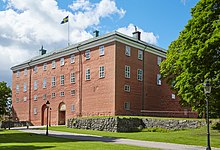Västerås Castle
The Västerås Castle is located in the Swedish town of Västerås , near the mouth of the river Svartån into the lake Mälaren . It has been classified as Byggnadsminne since 1935 .
history
Västerås was called Västra Aros (western estuary) in the 12th century and was the seat of a bishopric during this time . It was the most important port for the transport of products from the Bergslagen region and, alongside Stockholm, the most important city on the Mälaren. There was a need for a residence for the royal bailiff , which could also function as a protective building. A defense tower with four floors was built, on the top floor of which the defensive riflemen were posted. This tower still exists today on the northeast corner of the castle.
Västerås experienced several disputes and so the castle was expanded in stages. The castle played an important role in the fighting during the Kalmar Union and was the first major facility to be conquered by the rebels during the Engelbrekt uprising . The castle was conquered by Archbishop Jöns Bengtsson Oxenstierna in 1454 and Christian I had it besieged unsuccessfully in 1464. In 1522 Gustav Wasa captured the castle after it had been in Danish hands for a year.
Gustav Wasa made the palace a royal residence and held two diets in Västerås, which were important milestones in Swedish history. At the Diet of 1527 , the Reformation entered Sweden and the bond with the Catholic Church in Rome was cut. The electoral monarchy was abolished at the Reichstag in 1544. Before the last-mentioned Reichstag, the palace was rebuilt several times. A new king floor was set up above the eastern wing, where today's main entrance was built. The western wing was also extended. Later in the 1570s, under Johann III. a large negotiating hall and a castle church.
When Katharina von Pfalz-Kleeburg, the mother of Karl X. Gustav died in 1638, the time of the palace as a royal residence ended. This caused the building to slowly deteriorate. Renovation began in the late 17th century under the direction of the architect Mathias Spieler. Charles XII. used the castle in wartime just like other castles and fortresses as a prison camp. Erik XIV had already been imprisoned in the castle for a year in 1573 .
In 1736 a big fire broke out in the castle, with all facilities from the Wasa period and several wooden buildings in the area being destroyed. The subsequent renovation and expansion of the castle between 1740 and 1750 was headed by Carl Hårleman . During the general renovation in the 1920s by the city architect Erik Hahr, the focus was primarily on the negotiation room, the adjoining rooms and the residential floor.
Since 1889 there has been a collection of prehistoric objects in the castle. When the provincial administration moved into their new town house in 1961, the castle was renovated again in 1965-66 under Nils Tesch . The Provincial Museum of Västmanland then moved in, but was given a new building in 2010. A small part of the castle has been expanded as a residence for the Landshövding in recent years . Another part is used by the Mälardalen University .
literature
- Tord O: son Nordberg: Västerås slott: en byggnadshistorisk skildring. Västerås 1975.
- Ruth Hedlund: Västerås slott: fogdeborg, kungaslott, fängelse och residens. Västmanlands läns museum, Västerås 1990, ISBN 91-970290-3-3
Web links
- Entry in the Bebyggelseregistret des Riksantikvarieämbetet (Swedish)
Coordinates: 59 ° 36 ′ 23 ″ N , 16 ° 32 ′ 40 ″ E
